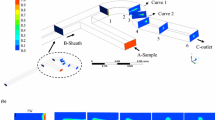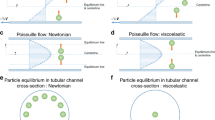Abstract
Hydrodynamic focusing has proven to be a useful microfluidics technique for the study of systems under rapid mixing conditions. Most studies to date have used a “push” configuration, requiring multiple pumps or pressure sources that complicate implementation and limit applications in point-of-care environments. Here, we demonstrate a simplified hydrodynamic focusing approach, in which a single pump pulling at the device outlet can be used to drive hydrodynamic focusing with not only excellent control over the focus width and stream velocity, but also with minimal sample consumption. In this technique, flow can be either mechanically driven or induced simply through capillarity.




Similar content being viewed by others
References
Brody JP, Yager P, Goldstein RE, Austin RH (1996) Biotechnology at low Reynolds numbers. Biophys J 71:3430–3441
Carslaw HS, Jaeger JC (1959) Conduction of heat in solids. Oxford University Press, New York
Kauffmann E, Darnton NC, Austin RH, Batt C, Gerwert K (2001) Lifetimes of intermediates in the β-sheet to α-helix transition of β-lactoglobulin by using a diffusional IR mixer. Proc Natl Acad Sci USA 98:6646–6649
Knight JB, Vishwanath A, Brody JP, Austin RH (1998) Hydrodynamic focusing on a silicon chip: mixing nanoliters in microseconds. Phys Rev Lett 80(17):3863–3866
Lipman EA, Schuler B, Bakajin O, Eaton WA (2003) Single-molecule measurement of protein folding kinetics. Science 301:1233–1235
Pabit SA, Hagen SJ (2002) Laminar-flow fluid mixer for fast fluorescence kinetics studies. Biophys J 83:2872–2878
Pollack L, Tate MW, Darnton NC, Knight JB, Gruner SM, Eaton WA, Austin RH (1999) Compactness of the denatured state of a fast-folding protein measured by submillisecond small-angle X-ray scattering. Proc Natl Acad Sci USA 96:10115–10117
Russell R, Millett IS, Tate MW, Kwok LW, Nakatani B, Gruner SM, Mochrie SGJ, Pande V, Doniach S, Herschlag D, Pollack L (2002) Rapid compaction during RNA folding. Proc Natl Acad Sci USA 99(7):4266–4271
Song H, Ismagilov RF (2003) Millisecond kinetics on a microfluidic chip using nanoliters of reagents. J Am Chem Soc 125:14613–14619
Vestad T, Marr DWM, Oakey J (2004) Flow control for capillary-pumped microfluidic systems. J Micromech Microeng 14:1503
Acknowledgements
This work was partially supported by NIH grant no. R21 EB0001722-01, NSF grant no. 0097841, and NASA grant no. NAG9-1364.
Author information
Authors and Affiliations
Corresponding author
Rights and permissions
About this article
Cite this article
Stiles, T., Fallon, R., Vestad, T. et al. Hydrodynamic focusing for vacuum-pumped microfluidics. Microfluid Nanofluid 1, 280–283 (2005). https://doi.org/10.1007/s10404-005-0033-z
Received:
Accepted:
Published:
Issue Date:
DOI: https://doi.org/10.1007/s10404-005-0033-z




